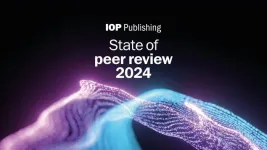(Press-News.org) In a new study published in PeerJ Life & Environment, scientists have revealed the intricate vocal patterns of Bornean orangutans, shedding new light on the complexities of their communication. Titled "Vocal Complexity in the Long Calls of Bornean Orangutans," the research, led by Dr. Wendy Erb from the K. Lisa Yang Center for Conservation Bioacoustics at the Cornell Lab of Ornithology, unveils the remarkable diversity and variability within orangutan long call vocalizations.
Orangutans, the charismatic great apes of Southeast Asia, are known for their complex social behaviors and vocal communication. However, understanding the nuances of their vocal repertoire has posed a significant challenge for researchers. Dr. Wendy Erb and her team embarked on a pioneering journey to decipher the mysteries of orangutan vocalizations, and their findings are set to revolutionize our understanding of these remarkable primates.
Dr. Erb, a primatologist specializing in the behavior and communication of wild primates, explained the motivation behind the study: "Our research aimed to unravel the complexities of orangutan long calls, which play a crucial role in their communication across vast distances in the dense rainforests of Indonesia. Over the course of three years, we accumulated hundreds of long call recordings, revealing a fascinating array of vocal diversity."
The study employed a multidimensional approach, combining traditional audio-visual methods with state-of-the-art machine learning techniques. Dr. Erb and her team meticulously analyzed the long calls of 13 individual orangutans, aiming to determine the number of pulse types present in their vocalizations and evaluate their gradation.
"Through a combination of supervised and unsupervised analytical methods, we identified three distinct pulse types that were well differentiated by both humans and machines," Dr. Erb elaborated. "While our study represents a significant step forward in understanding orangutan communication, there is still much to uncover. Orangutans may possess a far greater repertoire of sound types than we have described, highlighting the complexity of their vocal system."
The research not only deepens our understanding of orangutan communication but also underscores the broader concept of vocal complexity in the animal kingdom. Dr. Erb emphasized the collaborative effort behind the study, acknowledging the dedication of her team and the importance of interdisciplinary collaboration in scientific research.
"This study represents the culmination of months of hard work and collaboration, demonstrating the power of collective effort in advancing our understanding of nature's intricacies," Dr. Erb stated. "We hope that our findings inspire further exploration of vocal complexity across different species and pave the way for future discoveries in animal communication."
The full study, "Vocal Complexity in the Long Calls of Bornean Orangutans," is published Open Access in PeerJ Life & Environment.
For media inquiries or interview requests with Dr. Wendy Erb, please contact:
wme8@cornell.edu
END
Scientists unlock mysteries of orangutan communication
2024-05-14
ELSE PRESS RELEASES FROM THIS DATE:
Researchers create human aortic aneurysm model to advance disease understanding, treatment testing
2024-05-14
Using human cells in laboratory rats, Michigan Medicine researchers have developed a functional model of thoracic aortic aneurysm, creating opportunities for more effective understanding of disease development and treatments for the potentially fatal condition, a study suggests.
There are currently no medical treatments for thoracic aortic aneurysm, which is a weakening and bulging at the body’s largest blood vessel in the chest.
The aneurysm often does not cause any symptoms and must ...
Over 20,000 people join search for new dementia treatments
2024-05-14
More than 20,000 volunteers have been recruited to a resource aimed at speeding up the development of much-needed dementia drugs. The cohort will enable scientists in universities and industry to involve healthy individuals who may be at increased risk of dementia in clinical trials to test whether new drugs can slow the decline in various brain functions including memory and delay the onset of dementia.
Using the resource, scientists have already been able to show for the first time that two important bodily mechanisms – inflammation and metabolism – play a role in the decline in brain function as we age.
By ...
Artificial intelligence tool detects sex-related differences in brain structure
2024-05-14
Artificial intelligence (AI) computer programs that process MRI results show differences in how the brains of men and women are organized at a cellular level, a new study shows. These variations were spotted in white matter, tissue primarily located in the human brain’s innermost layer, which fosters communication between regions.
Men and women are known to experience multiple sclerosis, autism spectrum disorder, migraines, and other brain issues at different rates and with varying symptoms. A detailed understanding of how ...
A bionanomachine for green chemistry
2024-05-14
Researchers at the Paul Scherrer Institute PSI have for the first time precisely characterised the enzyme styrene oxide isomerase, which can be used to produce valuable chemicals and drug precursors in an environmentally friendly manner. The study appears today in the journal Nature Chemistry.
Enzymes are powerful biomolecules that can be used to produce many substances at ambient conditions. They enable “green” chemistry, which reduces environmental pollution resulting from processes used in synthetic chemistry. One such tool from nature has now been characterised in detail by ...
How wildfires change soil chemistry
2024-05-14
The huge, long-lasting wildfires that have become increasingly common in recent years can cause changes in soil chemistry that affect water contamination, air quality, and plant growth. But these changes are poorly monitored and rarely factor into post-fire recovery efforts or risk assessments, according to a review study published May 14 in Nature Reviews Earth & Environment.
The study, led by Stanford University and Colorado State University scientists, found that better techniques are needed to monitor changes in soil and surrounding ecosystems. This enhanced ...
Genes driving age-related blood cell mutations uncovered
2024-05-14
Scientists have discovered 17 additional genes that drive the abnormal overgrowth of mutated blood cells as we age. The findings, published today (14 May) in Nature Genetics, provide a more complete view of the genetic factors behind clonal haematopoiesis – a process associated with ageing and linked to increased risks of blood cancers1.
Researchers from the Wellcome Sanger Institute, Calico Life Sciences, California, and the University of Cambridge analysed sequencing data from over 200,000 individuals in the UK Biobank cohort. They searched for genes showing signals of "positive selection" – where mutations ...
WASP-193b, a giant planet with a density similar to that of cotton candy
2024-05-14
An international team led by researchers from the EXOTIC Laboratory of the University of Liège, in collaboration with MIT and the Astrophysics Institute in Andalusia, has just discovered WASP-193b, an extraordinarily low-density giant planet orbiting a distant Sun-like star.
This new planet, located 1,200 light-years from Earth, is 50% larger than Jupiter but seven times less massive, giving it an extremely low density comparable to that of cotton candy. "WASP-193b is the second least dense planet discovered to date, after Kepler-51d, which is much smaller," explains ...
IOP Publishing report reveals peer review capacity not used to its full potential
2024-05-14
A new global study from IOP Publishing (IOPP) has found that certain peer review communities continue to feel overburdened by reviewer requests, while others remain underrepresented.
The survey, which generated over 3,000 responses from peer reviewers from across the globe, revealed regional and career-stage disparities:
30% of reviewers from high-income countries indicated that they receive too many peer review requests, compared with just 10% from low and middle-income countries*
Just 6% of respondents from China and 7% from India indicated that they ...
Eco-friendly and affordable battery for low-income countries
2024-05-14
A battery made from zinc and lignin that can be used over 8000 times. This has been developed by researchers at Linköping University, Sweden, with a vision to provide a cheap and sustainable battery solution for countries where access to electricity is limited. The study has been published in the journal Energy & Environmental Materials.
“Solar panels have become relatively inexpensive, and many people in low-income countries have adopted them. However, near the equator, the sun sets at around 6 PM, leaving households and businesses without electricity. The hope is that ...
New transit station in Japan significantly reduced cumulative health expenditures
2024-05-14
The declining population in Osaka is related to an aging society that is driving up health expenditures. Dr. Haruka Kato, a junior associate professor at Osaka Metropolitan University, teamed up with the Future Co-creation Laboratory at Japan System Techniques Co., Ltd. to conduct natural experiments on how a new train station might impact healthcare expenditures.
JR-Sojiji Station opened in March 2018 in a suburban city on the West Japan Railway line connecting Osaka and Kyoto. The researchers used a causal impact algorithm to analyze the medical expenditure data gathered from the time series medical ...



